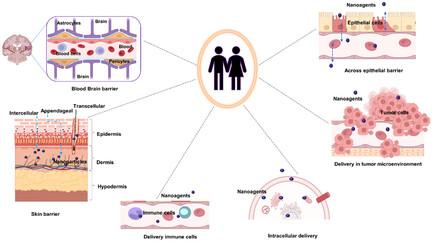Transformative Impact of Nanocarrier-Mediated Drug Delivery: Overcoming Biological Barriers and Expanding Therapeutic Horizons
IF 11.1
Q1 MATERIALS SCIENCE, MULTIDISCIPLINARY
引用次数: 0
Abstract
Advancing therapeutic progress is centered on developing drug delivery systems (DDS) that control therapeutic molecule release, ensuring precise targeting and optimal concentrations. Targeted DDS enhances treatment efficacy and minimizes off-target effects, but struggles with drug degradation. Over the last three decades, nanopharmaceuticals have evolved from laboratory concepts into clinical products, highlighting the profound impact of nanotechnology in medicine. Despite advancements, the effective delivery of therapeutics remains challenging because of biological barriers. Nanocarriers offer a solution with a small size, high surface-to-volume ratios, and customizable properties. These systems address physiological and biological challenges, such as shear stress, protein adsorption, and quick clearance. They allow targeted delivery to specific tissues, improve treatment outcomes, and reduce adverse effects. Nanocarriers exhibit controlled release, decreased degradation, and enhanced efficacy. Their size facilitates cell membrane penetration and intracellular delivery. Surface modifications increase affinity for specific cell types, allowing precise treatment delivery. This study also elucidates the potential integration of artificial intelligence with nanoscience to innovate future nanocarrier systems.

纳米载体介导的药物传输的变革性影响:克服生物障碍,拓展治疗领域
推动治疗进展的核心是开发能够控制治疗分子释放、确保精确靶向和最佳浓度的给药系统(DDS)。靶向给药系统可提高疗效,最大限度地减少脱靶效应,但也存在药物降解的问题。在过去三十年中,纳米药物已从实验室概念发展成为临床产品,凸显了纳米技术对医学的深远影响。尽管取得了进步,但由于生物障碍,有效输送治疗药物仍是一项挑战。纳米载体以其体积小、高表面体积比和可定制的特性提供了一种解决方案。这些系统可应对剪切应力、蛋白质吸附和快速清除等生理和生物挑战。它们可以定向输送到特定组织,改善治疗效果,减少不良反应。纳米载体具有控释、减少降解和提高疗效的特点。它们的尺寸有利于细胞膜穿透和细胞内输送。表面修饰可增加对特定细胞类型的亲和力,从而实现精确的治疗递送。这项研究还阐明了人工智能与纳米科学的潜在结合,以创新未来的纳米载体系统。
本文章由计算机程序翻译,如有差异,请以英文原文为准。
求助全文
约1分钟内获得全文
求助全文
来源期刊
CiteScore
14.00
自引率
2.40%
发文量
0
期刊介绍:
Small Science is a premium multidisciplinary open access journal dedicated to publishing impactful research from all areas of nanoscience and nanotechnology. It features interdisciplinary original research and focused review articles on relevant topics. The journal covers design, characterization, mechanism, technology, and application of micro-/nanoscale structures and systems in various fields including physics, chemistry, materials science, engineering, environmental science, life science, biology, and medicine. It welcomes innovative interdisciplinary research and its readership includes professionals from academia and industry in fields such as chemistry, physics, materials science, biology, engineering, and environmental and analytical science. Small Science is indexed and abstracted in CAS, DOAJ, Clarivate Analytics, ProQuest Central, Publicly Available Content Database, Science Database, SCOPUS, and Web of Science.

 求助内容:
求助内容: 应助结果提醒方式:
应助结果提醒方式:


